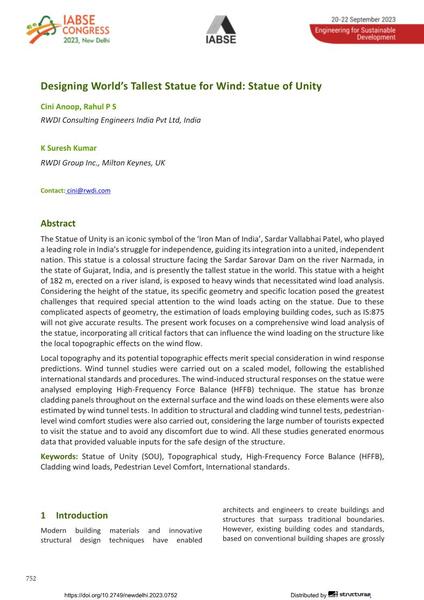Designing World’s Tallest Statue for Wind: Statue of Unity

|
|
|||||||||||
Détails bibliographiques
| Auteur(s): |
Cini Anoop
(RWDI Consulting Engineers India Pvt Ltd, India)
P. S. Rahul (RWDI Consulting Engineers India Pvt Ltd, India) K. Suresh Kumar (RWDI Group Inc., Milton Keynes, UK) |
||||
|---|---|---|---|---|---|
| Médium: | papier de conférence | ||||
| Langue(s): | anglais | ||||
| Conférence: | IABSE Congress: Engineering for Sustainable Development, New Delhi, India, 20-22 September 2023 | ||||
| Publié dans: | IABSE Congress New Delhi 2023 | ||||
|
|||||
| Page(s): | 752-759 | ||||
| Nombre total de pages (du PDF): | 8 | ||||
| DOI: | 10.2749/newdelhi.2023.0752 | ||||
| Abstrait: |
The Statue of Unity is an iconic symbol of the ‘Iron Man of India’, Sardar Vallabhai Patel, who played a leading role in India's struggle for independence, guiding its integration into a united, independent nation. This statue is a colossal structure facing the Sardar Sarovar Dam on the river Narmada, in the state of Gujarat, India, and is presently the tallest statue in the world. This statue with a height of 182 m, erected on a river island, is exposed to heavy winds that necessitated wind load analysis. Considering the height of the statue, its specific geometry and specific location posed the greatest challenges that required special attention to the wind loads acting on the statue. Due to these complicated aspects of geometry, the estimation of loads employing building codes, such as IS:875 will not give accurate results. The present work focuses on a comprehensive wind load analysis of the statue, incorporating all critical factors that can influence the wind loading on the structure like the local topographic effects on the wind flow. Local topography and its potential topographic effects merit special consideration in wind response predictions. Wind tunnel studies were carried out on a scaled model, following the established international standards and procedures. The wind-induced structural responses on the statue were analysed employing High-Frequency Force Balance (HFFB) technique. The statue has bronze cladding panels throughout on the external surface and the wind loads on these elements were also estimated by wind tunnel tests. In addition to structural and cladding wind tunnel tests, pedestrian- level wind comfort studies were also carried out, considering the large number of tourists expected to visit the statue and to avoid any discomfort due to wind. All these studies generated enormous data that provided valuable inputs for the safe design of the structure. |
||||
